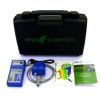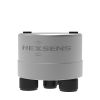Eno Scientific Well Watch 670 Water Level Monitor
Features
- Built-in display allows for view of real-time data and control of settings
- Data logger stores up to 25 million time/date stamped log points
- SCADA & telemetry compatible
- Free ground shipping
- Expedited repair and warranty service
- Lifetime technical support
- More
Overview
The Eno Scientific Well Watch 670 is a line of sonic water level meters designed for semi-permanent installation. These units utilize sound waves and adaptive sensor technology to learn the makeup of a particular well allowing for the most accurate readings. The Well Watch meters were designed to be a solution for the long term monitoring needs of agricultural, municipal, environmental or production well owner/operators.
Design
The Well Watch 670 includes a built-in display with keypad which allows the user to view real time data and to easily control the internal settings. It also has a built-in data logger capable of logging up to 25 million time/date stamped data points. This is the perfect tool to monitor and trend water levels and usage. Utilize this data to prevent over use of a well and save a potential costly repair from a burned up pump.
Installation
These units are easy to install in virtually any well setup. Each Well Watch unit comes with 3 MPT threaded nozzles, 1/2", 3/4" and 1" in diameter. Simply choose the nozzle which fits into the vent hole on the well seal and screw the Well Watch tightly in place. Attachments can be used to angle the units for tight fitting spaces since the Well Watch does not need to be vertical to get a good reading. Then, choose from the multiple output options available to work with the chosen application, including RS232, RS485 (Modbus), 4-20mA, 0-5V Analog, and USB. These are a perfect for monitoring remote wells or as a back up in case of a SCADA system crash.
- Well Watch
- 3 Nozzles (1/2", 3/4", 1")
- Microphone extension tube
- A/C Power adapter
In The News
From Hurricanes to Florida’s Red Tides: Monitoring the Southwest Gulf Coast
Nearly every year, southwest Florida is blighted by harmful Karenia brevis blooms–known colloquially as Florida red tides. These harmful algal blooms (HABs) form over the West Florida shelf and are pushed shorewards by winds and currents. Once in touching distance of the coast, they often intensify, fed by land-based runoff, anthropogenic nutrients, and decomposing marine life killed by toxins produced by these red tides. Red tides have become more severe and persistent over the past 20 years, causing major environmental and economic damage.
Read MoreWave-Powered Buoy Deployed in Puget Sound
While the development of solar-powered monitoring systems has improved access to real-time environmental data, solar power is still limited by low light conditions, such as poor weather, nighttime, or high-latitude environments. To supplement these incumbent power solutions at sea, Ocean Motion Technologies has developed a small-scale ocean wave energy system that can be directly integrated with existing data buoy platforms. Not only does wave energy supplement solar power during periods when the buoys are limited by light availability, but it also allows data buoys to perform beyond their current power capacities.
Read MoreLong-Term Monitoring in the Chautauqua Lake Watershed
With a widely developed shoreline, Chautauqua Lake experiences influxes of non-point source pollution that have historically impacted the health of the lake. The Chautauqua Lake Association (CLA) has been monitoring the lake for over two decades, reporting on changes that have occurred over the years. A pair of local lake advocates, Jane and Doug Conroe, have lived on the lake for over 40 years and have played an important role in establishing monitoring programs and facilitating consistent data collection throughout the watershed. Doug has been involved with the Chautauqua Lake Association (CLA) since the pair moved to the area in 1980, and is currently serving as the Executive Director.
Read More


















